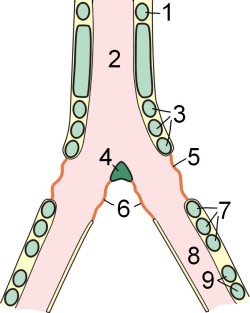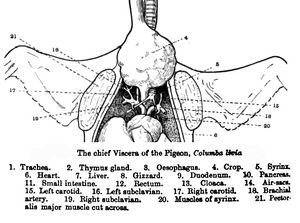Syrinx (bird anatomy) facts for kids

1: last free ring of the windpipe, 2: Windpipe (Trachea) 3: first group of syrinx rings, 4: pessulus (a special bone), 5: outer membrane, 6: inner membrane, 7: second group of syrinx rings, 8: main bronchus (tube to lung), 9: cartilage of the bronchus

The syrinx (say "SEER-inks") is like the "voice box" for birds. It gets its name from an old Greek word for "pan pipes" because it helps birds make music! You can find it at the bottom of a bird's windpipe, right where the windpipe splits into two tubes that go to the lungs.
Unlike humans and other mammals who use vocal cords in their larynx to make sounds, birds use special vibrating parts in their syrinx. When air flows through the syrinx, it makes the walls (called membrana tympaniformis) and a small bone (the pessulus) vibrate. These vibrations create the sounds we hear, like chirps, squawks, and songs! Birds can change their sounds by tightening or loosening these parts with tiny muscles. This amazing organ even lets some birds, like parrots, crows, and mynas, copy human speech!
Birds do have a larynx, just like us, but it doesn't make sounds. The syrinx is unique because it's located where the windpipe divides. This special position means some songbirds can even make two different sounds at the same time! Imagine singing a duet all by yourself! However, not all birds have a syrinx. For example, New World vultures don't have one, so they just make hissing sounds.
How Birds Make Different Sounds
The syrinx isn't the same in all birds. Its shape, how it's built, and the muscles around it can be very different depending on the type of bird.
Parts of the Syrinx
The syrinx is made of special rings, like tiny hoops, that come from the windpipe and the tubes leading to the lungs. These rings are often made of a hard material, like bone. In many birds, the last few windpipe rings and the first few lung tube rings can join together to form a "tympanic box."
Inside the syrinx, there are thin parts called membranes. These membranes are the main parts that vibrate to create sound. Birds also have muscles that control the syrinx. Some muscles are inside the syrinx, and others are attached from the outside, like the sternotrachealis muscle that connects to the chest bone. All these parts work together to help birds make their wide range of calls and songs!
-
The cuckoo roller
See also





